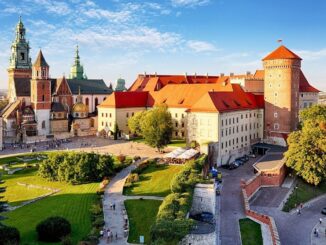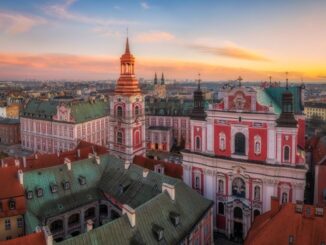Who needs chocolate when you can get your first whack of real energy in the morning through a quirky amber power wheel.
Owned by the fabulously eccentric couple Virginija and Kazimieras Mizgirs, the fun invention is housed in a small, but wonderful amber museum in the tiny resort town of Nida on the Curonian Spit in Lithuania, close to the Russian border.
Visitors are coaxed into holding hands in a circle by Kazimieras, who with a wicked glint in his eye, turns the wheels and zaps a fair chunk of voltage through everyone’s body, a Lithuanian’s take on a cold shower perhaps!

The museum, which has a vast modern collection of amber, made into weird and wonderful pieces, such as telephones, mouse traps and honey spoons, is just one of the many jewels in a part of the country mainly undiscovered by foreign visitors. Nida itself is full of colourful fisherman’s cottages, pine forests and some of Europe’s tallest sand dunes surround the town. There’s plenty of accommodation options too, including The Nerija Hotel, renowned for its food. Fresh fish is the staple diet served up in traditional local restaurants.
There’s a gentle air of contentment to this part of the world, with friendly locals, clean and pothole free streets and lots of art to jazz the place up, with Nida’s most prominent, being colourful weather vanes adorning the chimneys and lamp posts of the town, to mark its connection to the sea and as every boat had to have one, it was a way of identifying who owned which boat.
The Curonian Spit is a long curved sand dune which separates the Curonian Lagoon from the Baltic Sea and it’s inside the UNESCO protected national park, home to vast areas of forests and rich in wildlife and small communities. At one time it was the summer residence of the German novelist Thomas Mann, who famously wrote Death in Venice. His house is now a museum dedicated to his works.

Nida can be reached via UK flights to the country’s busiest coastal town of Palanga, which has a long sandy beach, backed by dunes and features a lovely old pier. This old-fashioned old spar town has the well-kept Birtue Park, and an impressive amber museum housed in the majestic Tiskevičius Palace among its attractions and many bars and restaurants to enjoy. The Spa Gradiali doubles up as a luxury hotel and a medical centre for wellness.
Flying into the tiny Palanga airport gives the traveller lots of options as to where to explore. A stay at the spa and wellness centre Atostogų Parkas, the biggest health and recreation complex in western Lithuania, sets you up well for a day looking around Kretinga, which was considered one of the most important trading centres in the region for Jewish and Prussian merchants.
Highlights include a visit to the Franciscan Monastery and 16th century church which has a fabulous marble altar, which deceives the eye, as it is actually made of traditional Lithuanian wood.

Nearby is The Kretinga Museum on Count Tiskevicius’s estate, which tells the tale of daily Lithuanian life and is in easy access of a gem of a local café which serves scrumptious cakes and candy. The winter gardens are a delight to explore and discover exotic plants.
Europe’s biggest Japanese garden is a short hop from the centre and is the brainchild of Japanese Master Hajime Watanabe and the Lithuanian doctor Šarūnas Kasmauskas and close by is the man-made cable park where you can dine at the Asian fusion Briusly Bar and try your hand at wakeboarding.
The oldest city of Klaipėda is a fascinating spot to explore, with a fabulous collection of sculptures on every street corner, from the cat with a face of a gentleman to a tiny wee mouse begging for cheese.

Just as famous is its carillon, a collection of 35 bells which ring every weekend and on important dates. Operated like an organ, but with hands bashing, rather than pulling the bells, it’s a lovely sound to hear, especially when you are enjoying the luxuries of newly opened Victoria Hotel, which is a short car journey away from Smiltynės Beach, with plenty of fine dining on tap.
Klaipėda has much to do, from a visit to the castle museum housed in the 16th to 18th century underground defensive galleries, to beer tasting at the country’s second oldest brewery, Švyturys. It’s just nice though to stroll around the city and enjoy its distinctive Prussian architecture or take a flame lit canoe ride through the old town and admire the mid-century Memel fortifications and historic embankments.
Close to the Curonian Lagoon is the small village of Dreverna, which has been transformed into a water resort for visitors, with accommodation and hospitality on tap. A cultural folklore programme, “I Will Become A Fisherman’’ enables visitors to sample local life, with Lithuanian traditional dancing, tasting of the local Memel wine and tours of traditional housing and villages on offer.

The Baltic Sea offers fine beaches, swirling waves and dramatic cliffs to enjoy, including the Dutchman’s Cap Cliff at the Seaside Regional Park, where you can feel the energy and vibrancy of a place just waiting to be explored!
For more tourist information, you can check out: www.visit-palanga.lt, http://visitneringa.com, www.klaipedatravel.lt and https://aplankykkretinga.lt/.
Author Bio:
Rebecca Hay is an experienced travel writer and member of The British Guild of Travel Writers. Follow her adventures with her family on Twitter and Instagram @emojiadventurer and on Facebook via EmojiAdventurers2.




Be the first to comment